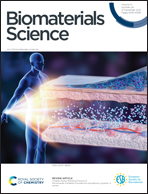The role of biomaterials and scaffolds in immune responses in regenerative medicine: macrophage phenotype modulation by biomaterial properties and scaffold architectures
Abstract
Scaffolds are an integral part of the regenerative medicine field. The contact of biomaterials with tissue, as was clearly observed over the years, induces immune reactions in a material and patient specific manner, where both surface and bulk properties of scaffolds, together with their 3D architecture, have a significant influence on the outcome. This review presents an overview of the reactions to the biomaterials with a specific focus on clinical complications with the implants in the context of immune reactions and an overview of the studies involving biomaterial properties and interactions with innate immune system cells. We emphasize the impact of these studies on scaffold selection and upscaling of microenvironments created by biomaterials from 2D to 3D using immune cell encapsulation, seeding in a 3D scaffold and co-culture with relevant tissue cells. 3D microenvironments are covered with a specific focus on innate cells since a large proportion of these studies used innate immune cells. Finally, the recent studies on the incorporation of adaptive immune cells in immunomodulatory systems are covered in this review. Biomaterial–immune cell interactions are a critical part of regenerative medicine applications. Current efforts in establishing the ground rules for such interactions following implantation can control immune response during all phases of inflammation. Thus, in the near future for complete functional recovery, tissue engineering and control over biomaterials must be considered at the first step of immune modulation and this review covers these interactions, which have remained elusive up to now.



 Please wait while we load your content...
Please wait while we load your content...